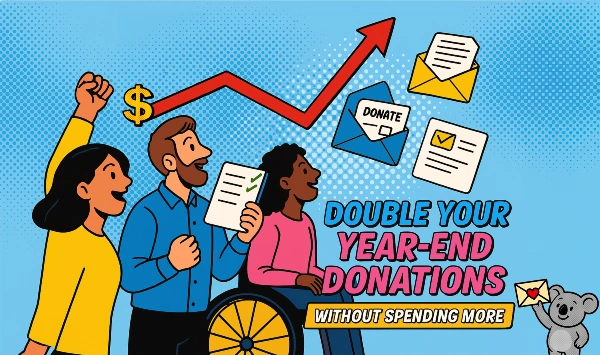So how often should you mail?
Pareto Fundraising, the company I co-founded before Moceanic, looks at data and tries to work out what the optimum communications program should be to maximise lifetime value from donors.
Donors are very expensive to get on board, and it is imperative that you look at your data to maximise return on that initial investment.
The most important factor for whether someone will give to you is whether they gave you previously.
Then, the most important variables are how recently and how many times. The more recent someone gave, the more likely they are to give again.
Let me say that again, because it’s so important, and you might not believe it: The more recent someone gave, the more likely they are to give again.
So, mailing, emailing or phoning more often means that you are constantly communicating with donors more recently, and therefore more likely to get gifts from them.
Also, the biggest cause of attrition is not giving for a while (!). Fewer communications mean that the gap between giving is greater.
If you don’t communicate very often, your attrition goes up, not down. Unless your communications are not very good.
When it comes to asking donors for a monthly gift we also note that there is an optimum time. It does vary slightly, depending on the cause, channel of solicitation, etc. but it is always going to be within a couple of months of a gift.
Four to six weeks is the right place to start. We are not alone with this approach, anyone else who measures lifetime value and optimum ‘conversion’ timings finds the same answer.
And this does not appear to vary between countries.
We took that learning from data in the UK and applied it in Australia to find the same.
Analysing data across other countries gives us the same result.
This approach is not aggressive and is not subjective or an opinion.
It is maths. Across any given data set, increasing communications tends to increase the lifetime value of that data set. Not just short-term income, but overall lifetime giving.
Managed well, it should also increase your number of bequests.
Moceanic’s fellow Fundraisingologist, Jeff Brooks advocates as many as thirty asks per annum.
That seems a lot, but he says that he has never seen increasing the number of asks decrease the total value given.
Create better donor communications than ever before – check out Jeff’s course!
The limit on the number of communications is likely to be forced on you for internal reasons – your capacity to produce multiple communications, for example.
Related blog: You have no dramatic stories to tell? You’re looking at it wrong!
Whilst increasing the number of asks (and appropriate thank yous) is likely to increase total given, and increase retention, each time it occurs also increases costs and reduces the amount given on that occasion.
Consequently, an initial increase in return on investment (ROI) as you go from say four to eight communications will reverse, and you will probably begin to see a decline as you go from say eight to sixteen.
Even so, net income is the best measure – not ROI – from warm mailings to your own donors.
It is better to raise $700k at a cost of $300k than $500k at a cost of $100k. More donors, more security, more room for error, more legacy potentials, etc = more money in the end.
So, how many times should you ask?
It depends – mostly on the size of your fundraising database, and on the fixed costs associated with pulling a mailing together – the costs of copy-writing, design, staff, etc.
More asks will most likely raise more, and improve donor retention and lifetime value – but they will cost more, and take more time.
Related: Here’s some tips to help overcome those barriers to mailing more.
Could that time be used more wisely? In the end, it comes down to maths, not donor fatigue.
I’ll try to illustrate it in this simple chart, showing three charities of various sizes. The columns recommend their total income, net income (profit) and their ROI (return on investment – how much you get back for every $1 you spend).*



What do you think? Do you mail your donors more frequently? Or do you try to keep the number of mailings low? Why?
Please share your experience by leaving your reply below this blog.
Sean
P.S. Jeff Brooks’ course Irresistible Communications for Great Nonprofits shows you step-by-step how to create perfect donor communications and raise more money for your cause. Check it out!
P.P.S. *A bit more detail for the modellers who are curious about my charts!
- Each charity spends an average of $1.20 per pack mailed, gets an average donation of $50 and has an average of 20% response rate when they mail twice a year.
- The average number of donors available to mail decreases as the number of mailings increa; reducing by 10% every time they double the number of mailings.
- In addition, the response rate decreases – from 20% for each of two mailings, then 16.6% for four mailings, 13.8% for eight, 12.4% for twelve and 11.5% for 16.












7 Comments. Leave new
Thanks for the great insight, Sean! Love seeing the numbers that justify constant interaction with your donors. We’re never at a loss of news or updates at Catholic Social Services (www.cssalaska.org).
Also great seeing “And this does not appear to vary between countries.” People are universally interested in hearing more about your agency and more likely to give if contacted more often.
Thanks!
-Russ
Thanks Russ! Especially important if you have good stuff to share like you do!
I’d say contacting donors when you don’t have anything relevant to share wouldn’t work as well.
Hi Sean,
Great article, thanks for sharing. At GoodUnited we’re in the process of testing a similar data set for email comms. We’ve already proven out that increasing comms results in a higher percentage of unique opens and clicks over time. We’re now working on connecting the increase in engagement to giving. Have you done a similar test on emails yet?
Thanks,
Jeremy
Thanks Jeremy. Please share your results when you have them!
I haven’t done a split test on cohorts over a long period of time, which is what needs to be done. Clicks and opens are the precursors to interaction and donations, and I am focused on the absolute number of interactions and donations, not the percentage per email.
However whilst several emails for one appeal campaign in short period of time will definitely get more clicks, opens, interactions and donations the big measure is what impact that has over a long time, say 15 months, when the unsubscribes are taken into account. My hypothesis: More unsubscribes, more donations, more interactions, more revenue for cause.
Hi Sean, I’m confused: how does more unsubscribes lead to more donations?
Alena, I see what you mean!
It should be:
“My hypothesis: More donations, more interactions, more revenue for cause, DESPITE More unsubscribes.
Sean
Thank you, thank you, thank you! I am in the process of attempting to assure a client that soliciting 3-5 times a year is not too many. This will be extremely helpful in making the case!